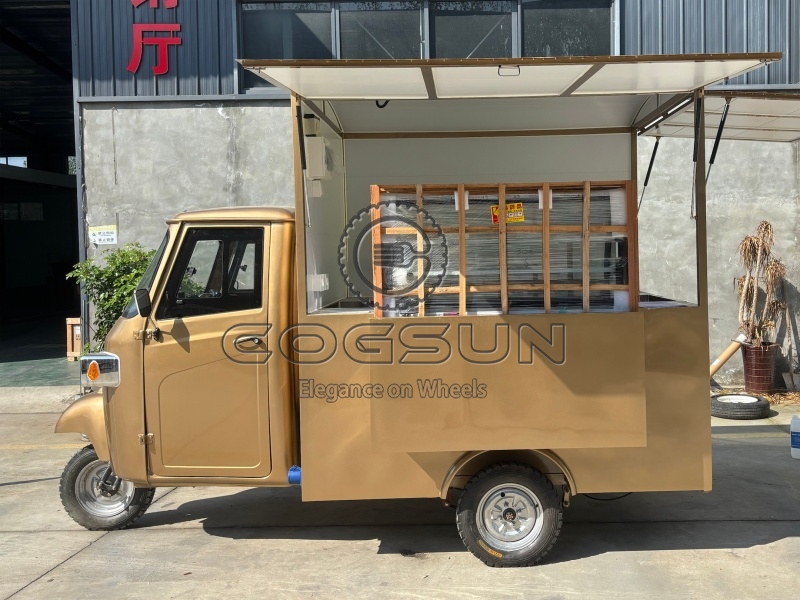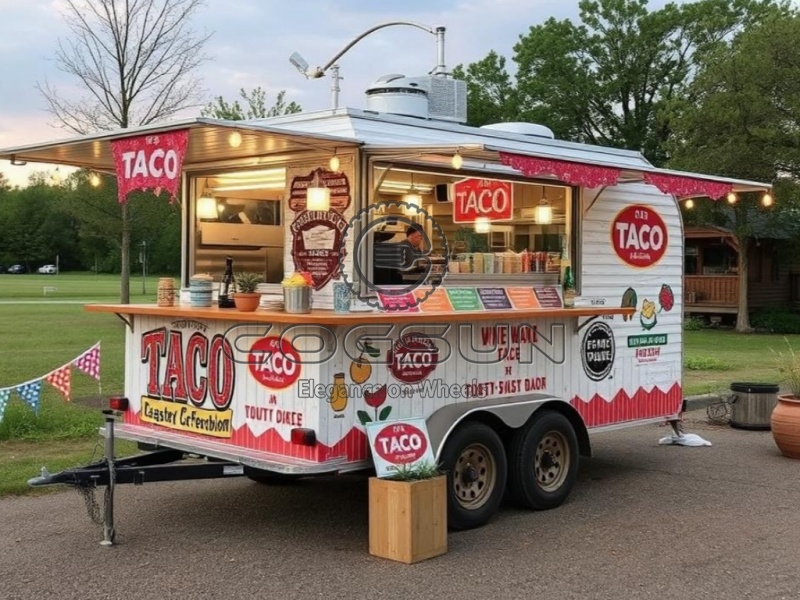Lunch Trailers are mobile kitchens designed for quick and convenient meal delivery, integrating food storage, cooking, packaging, and sales. Their core purpose is to meet the demand for on-the-go dining in high-traffic environments, such as office spaces, construction sites, schools, exhibitions, and transportation hubs. Through their modular design and flexible deployment capabilities, lunch trailers can replace traditional fixed restaurants, offering a diverse menu at a lower cost and higher efficiency while maintaining food safety and environmental protection requirements. They have become a key enabler of the “light dining” model in modern cities.
Key Features
1.High Mobility and Rapid Deployment
- Lightweight Body: Crafted from aluminum alloy or fiberglass, they reduce weight while improving corrosion resistance, making them adaptable to various road conditions and towing vehicles.
- Standardized Interfaces: A modular design with water and electricity connections enables site docking and equipment startup within 10 minutes.
- Foldable Structure: Select models feature a retractable worktop and awning, adapting to confined spaces or for temporary expansion.
2.Intelligent Operational Support
- Temperature Control IoT System: Real-time monitoring of refrigerator and steam oven temperatures, providing automatic alarms for abnormalities, ensuring food safety.
- Order Management Platform: Integrates online ordering, payment, and queue queuing functions, reducing on-site wait times.
- Energy Optimization Technology: Utilizes a heat recovery device and variable-frequency compressor to reduce energy consumption by over 30%.
3.Environmentally Friendly and Safety Design
- Wastewater Recycling System: Equipped with an oil-water separator and wastewater recovery tank, it meets environmental emission standards.
- Fire and Explosion Prevention: Gas leak alarms, automatic fire extinguishing systems, and explosion-proof circuit design ensure safe operation.
- Accessibility: Optional low-level windows and a voice ordering system accommodate individuals with disabilities and other special needs.
Internal Equipment Configuration
1.Food Processing and Storage Area
- Multi-temperature Refrigerator: Compartmentalized storage for fresh produce, dairy products, and prepared foods, with precise temperature control from 0-4°C.
- Quick Freezer: For temporary storage of frozen food, with temperatures reaching -18°C.
- Smart Rice Cabinet and Vegetable Rack: Automated metering and dispensing reduce waste and improve meal preparation efficiency.
2.Cooking and Processing Area
- High-efficiency Steam Oven: Supports three-in-one steaming, baking, and microwave functions, capable of preparing 50 meals per serving.
- Induction Cooker and Deep Fryer Combination: Meets diverse cooking needs, including Chinese stir-frying and Western frying.
- Automatic Stir-frying Robot (Optional): Pre-set recipe programs ensure standardized food preparation, reducing labor costs.
3.Packaging and Sales Area
- Insulated Food Pickup Station: Equipped with a heating lamp and compartmentalized trays to maintain food temperature and hygiene.
- Self-Service Ordering Terminal: Supports QR code ordering, membership points, and nutrition labeling, enhancing the customer experience.
- POS and Cashier System: Integrated data analysis capabilities generate sales heat maps and inventory alert reports.
4.Cleaning and Maintenance Area
- High-pressure Washing Sink: Equipped with a rotating nozzle, quickly cleans tableware and kitchenware.
- Disinfection Cabinet and Garbage Disposer: Disinfects tableware with ultraviolet light and shreds waste for legal disposal.
- Tool Storage Wall: Organizes knives, cutting boards, and cleaning supplies for improved space utilization.
Application
1.Corporate and Institutional Catering Services
- Campus/Office Building Catering: Provides weekday lunch packages for technology parks and office buildings, supporting group meal reservations and personalized customization.
- School Meal Delivery: Collaborates with primary and secondary schools to design low-fat and low-salt menus based on dietary guidelines to ensure student health.
2.Temporary Event and Exhibition Support
- Large Exhibition Catering: Deploys multiple catering trailers at the exhibition site to cater to diverse tastes (e.g., Chinese light meals, Western salads).
- Sports Event Supply Station: Provides high-energy meals and drinks for marathons, football matches, and other events, supporting rapid delivery and mobile supply.
3.Community and Public Welfare Services
- Senior Dining Hall Extension Services: Provides home delivery services for elderly residents living alone in the community, with trailers serving as branch locations for the central kitchen.
- Emergency Disaster Catering: Rapidly deploys after natural disasters, providing hot meals and drinking water to reassure affected residents.
4.Business Operations and Brand Development
- Chain Restaurants Exploring New Markets: Using trailers to test regional taste preferences at low cost can help optimize store location strategies.
- IP co-branded pop-up store: Cooperate with popular IPs to launch themed meals (such as anime character set meals) to attract young consumers to check in.





